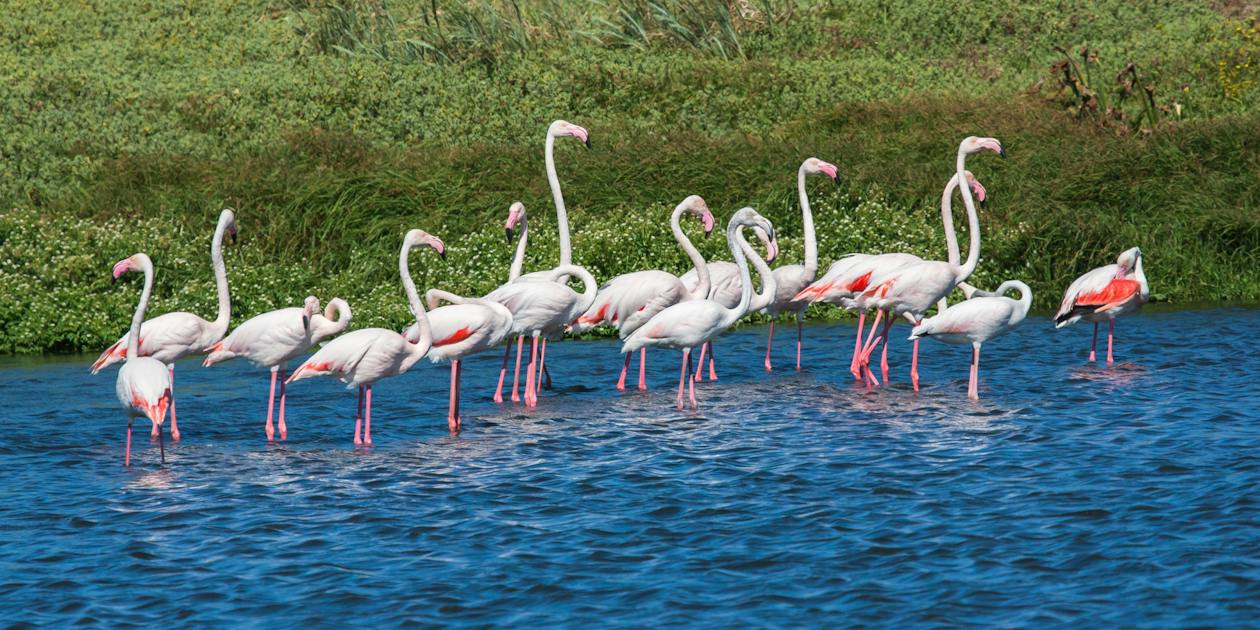Pink, tall, slender, and an excellent flyer—this is a Greater Flamingo. This species of flamingo is particularly famous for its pink color, making it an adorable bird to watch in Africa. Tourists worldwide come to Africa to observe these spectacular birds and their fascinating display of performances.
Read further to know more about the Greater Flamingo!
What is the Greater Flamingo?
Common name: Greater Flamingo
Scientific name: Phoenicopterus roseus
Type: Birds
Diet: Omnivore
Group name: Colony
Size: 36 to 50 inches
Wingspan: 60 inches
Weight: 8.75 pounds
As its name suggests, it is one of the largest and widespread species of flamingos you can find in the world. This large bird is present in parts of India, the Middle East, southern Europe, and is most widespread in Africa.
This species was first described in 1811 by Prussian zoologist and botanist Peter Simon Pallas. Initially, it was thought that the Greater Flamingo was the same as the American Flamingo. But because some of their body parts differ significantly, people considered them separate species.
Since the Greater Flamingo’s population is nowhere near extinction, the International Union for Conservation of Nature classified the species as “Least Concern.”
Its seven levels of scientific classification are as follows:
Kingdom: Animalia
Phylum: Chordata
Class: Aves
Order: Phoenicopteriformes
Family: Phoenicopteridae
Genus: Phoenicopterus
Species: P. roseus
Physical description of a Greater Flamingo
The Greater Flamingo is famed for its pink color. In fact, this animal is likely to be the only towering, pink bird that exists.
An adult Greater Flamingo has soft pink to whitish-pink plumage in general, though there are moments when it becomes very white in color. Its underwings are coral red, while its flight feathers are colored black. Its head shares the same color with its body plumage, with a well-adapted bent bill with black tips. The Greater Flamingo’s bill is curved downwards, which allows them to hunt for fish, plankton, and the like.
Its eyes are yellow in color. Its long, slender legs and webbed feet are pink in color. Both male and female Greater Flamingos have long legs, though a male Greater Flamingo is slightly longer than a female one. The largest male flamingo ever lived was recorded at up to 187 cm tall and 4.5 kg.
A chick is covered in grey-brown plumage with pale underparts. Its bill is bluish-gray, its feet are grey, and it has dark eyes. It has a straight bill that curves downwards as it age.
Greater Flamingo’s distribution and habitat
The Greater Flamingo flock in large numbers across the African continent. It is present in countries such as Namibia, Tanzania, Kenya, and Botswana.
Greater Flamingos usually flock in large and shallow alkaline or saline inland lakes, lagoons, and estuaries. In the western region of Africa, they are found in sandbanks and mudflats.
Most of the time, a number is sighted in open beaches, rocky or sandy islands, and salt pans.
Some of the best places to watch Greater Flamingos are the Makgadikgadi Salt Pans in Botswana, Walvis Bay and Swakopmund in Namibia, Lake Natron in Tanzania, and Lake Bogoria in Kenya.
A Greater Flamingo’s diet
This bird feeds on mud and will filter out any edible organisms in it. Various animals and organisms include shrimps, small fish, crabs, blue-green algae, mollusks, plankton, seeds, and insects. Sometimes, it consumes marsh grasses and decaying leaves.
When it’s hunting for food, the Greater Flamingo will walk along the water with its head submerged. After a while, it will raise its head at 5-25 seconds intervals to breathe. It will usually kick the mud using its feet to disturb the prey, making it easier to catch them.
More facts about the Greater Flamingo
Months before the breeding season, the Greater Flamingo will spend most of the time exhibiting collective displays in large flocks. This display consists of synchronized movements, dances, and postures. The most famous is the “head-flagging” movement, which is characterized by a stretched neck, with its head and bill pointing upwards.
Another spectacular movement is the “marching-display,” which shows a flock walking towards a single direction and then turning its tail feathers.
Before copulating, a pair of Greater Flamingos will display another performance before leaving the flock.
Greater Flamingos delight in taking a bath in shallow freshwater to remove the salt from its feathers. When they are taking a rest, it stands on one leg.
Another interesting trivia is that Greater Flamingos are excellent fliers, but it needs to run first before taking off. Its flight was described as “graceful and agile.”
Consequently, Greater Flamingos communicate with a goose-like honking. They feel safer in larger groups so that other birds can protect those who have their heads down in the mud and water from predators.
BOTSWANA BIRDS | SOUTH AFRICA BIRDS
NAMIBIA BIRDS | ZAMBIA BIRDS | ZIMBABWE BIRDS

